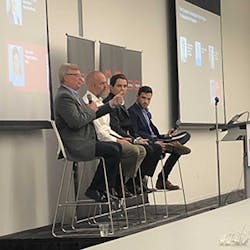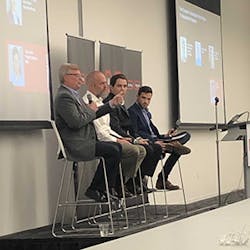Fixing digital manufacturing's missed connections
What does "digital manufacturing" mean to you? To your team members? (Have you asked?) A recent survey from manufacturing consultancy The Lucrum Group, conducted with Auburn University's engineering college and other industry partners, asked just that question, and among the manufacturing industry workers who responded, the No. 1 answer was "going paperless."
And therein lies a big part of the issue in why U.S. manufacturers, on the whole, have struggled to adopt new digital technologies—and, of more importance, new digitally enabled processes and Big Data-driven approaches to decision-making, The Lucrum Group's Christopher Peters said Tuesday. Vendors, academics and others who trade in such terms as Industry 4.0 and the IIoT often fail to appreciate that for a lot of manufacturing professionals across the country, "digital manufacturing" at its essence implies a shift away from paper record-keeping.
"They are not at the decision and implementation stage; they are at the knowledge and persuasion stage," said Peters, speaking at the "Industry 4.0: Closing the Loop Between Visionary and Practical" event held at digital manufacturing institute MxD in Chicago.
What's needed, Peters indicated, is a clearer understanding among U.S. manufacturers of all sizes of how digitalization can transform a manufacturing business—from moving to a more-predictive (vs. reactive or time-based) maintenance approach to creating new services-based lines of business to enabling more-agile, on-demand inventory management.
And that starts with better, standardized and more-accessible information about what exactly digital manufacturing entails—the kind of definition that Germany has done a great job with developing in seeking to explain Industry 4.0 for German businesses, Peters said. This summer, the team (facilitated by MxD) that worked on the digital manufacturing survey will launch an online resource hosted on the NIST website that answers—especially for small and midsize U.S. manufacturers—"What is digital manufacturing (DM)?" "How are my peers using DM? " and "How does DM help me?"
Starting digital transformation with a business problem that needs solving, rather than saying, "This seems like a cool technology; where can we use it?" is vital to the success of any digital initiative, other presenters and panelists at the event emphasized.
Big Picture Interview: Overwhelmed by the IIoT? Map technology to business needs, not vice-versa
Dan Rozinski, technology fellow at Dow Inc.
"'Business need first, technology second' is not as common (an approach) as you might think," said Craig Melrose, a partner at McKinsey & Co. But then, it's a truism that common sense is not so common, he noted. "What is my business need, and what is the digital solution that will help me get there?" should be the model, Melrose said.
Concerns from company executives and team leaders alike about getting stuck in "pilot purgatory" are valid, Melrose and other speakers said. And plant-floor workers are often skeptical about new "flavor-of-the-month" initiatives, having seen new tech or process-change efforts launch with much fanfare only to fall flat and be quietly abandoned somewhere down the line.
That's why realistic expectations and the business-need-first approach need to be solidly in place from the get-go, Melrose suggested.
"The pilot may not pay for itself; the scaling should," Melrose said. "Work on your top three business needs. What are the top three issues? Fix those. What are the next three? Fix those." And when it comes to metrics such as lead time and OEE, "you need to be expecting double-digit improvements," he said.
Jim Rocker, engineering manager at Duracell, said during a panel discussion that his company's approach to digitalization now often starts with a team identifying, "I wish we could do (so and so)" or "Shouldn't we be able to observe this?" and then sourcing and implementing digital tools that can help address that need.
That from-the-ground-up approach can be invaluable in adopting new tech and processes (and upskilling team members for these) in a way that leads to long-term success, noted Rocker's fellow panelist Dan Rozinski, technology fellow for engineering and manufacturing at Dow Inc. "We're looking for change agents in every site," Rozinski said—and Dow has 300 sites. "You need innovation not just from people whose job it is to innovate."

